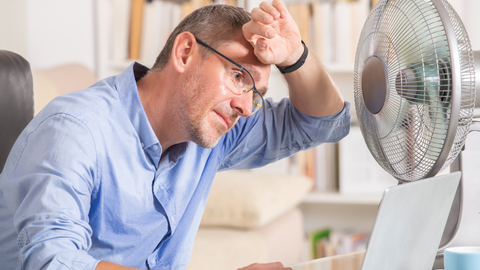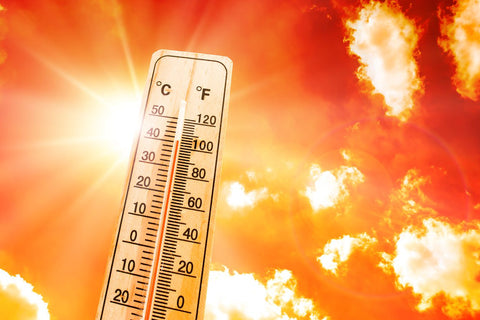
Extended periods of heat are dangerous for people of all ages, as they can lead to severe symptoms. The consequences of staying outside for too long during extremely hot weather include heat cramps, heat exhaustion, and heat stroke. Such emergencies can even be lethal. For instance, in 2021, a record-breaking US Pacific Northwest heat wave killed nearly 200 people.
That’s why heat wave safety is of utmost importance and shouldn’t be disregarded. Read ahead to find out how to prepare for such extreme weather, what to do during a heat wave, and how to deal with its aftermath.
Are Heat Waves Becoming More Common?

Heat waves are generally referred to as acute periods of extreme warmth, yet there is no standard definition for this natural event. This is mainly due to the diversity of communities engaged in heat wave monitoring and research.
While the experts’ opinions on the threshold values and duration of heat waves vary, the vast majority agree that they are becoming more common. This conclusion is supported by the data collected in major cities across the United States, where their frequency has been steadily increasing from an average of two heat waves per year during the 1960s to six per year during the 2010s.
Notably, the biggest increases in the number of heat wave days per year were registered in the Southeast and Great Plains regions, where over 12% of the land area experienced a significantly stronger impact than elsewhere in the continental US.
Such shifts are largely attributed to human-caused climate change, and the increase in heat wave frequency is most likely to continue.
Heat Wave Preparedness

As summer approaches, it’s especially important to check local news and weather reports for heat warnings.
Typically, a heat warning is released when daytime and nighttime temperatures or humidex (the value that combines temperature and humidity) are expected to exceed the average figures for 2 or more days in a row.
Make sure you know what to do in case of this emergency by implementing the heat wave safety tips listed in this guide:
1. Before a Heat Wave
The preparation for a heat wave should begin way before a warning is announced. Here are some things you can do:
- Find ways to keep cool before the extreme heat begins.
- Ensure you have air conditioning and fans at hand.
- Find out the location of the nearest municipal cooling centers.
- Discuss heat wave safety with the members of your household and create an emergency plan that takes into account not only your home but also places you commonly visit, such as work and school.
- Remember that power outages are common in hot weather due to the overload of electrical equipment.
- Receive first aid training to have the basic knowledge of how to deal with heat-related emergencies.
- Use sunscreen whenever you go outside - sunburned skin decreases the body’s ability to cool itself down.
- Stay hydrated at all times.
- If you have pets, ensure that their needs for water and shade are met.
- Keep in mind neighbors that may require extra assistance in the event of a heat wave, such as elderly people and children.
- Prepare an emergency kit with all the essential items you might need.
- Think of ways to entertain yourself and the household members during a heat wave without relying too much on electricity.
2. During a Heat Wave

Don’t underestimate the negative effects of heat waves and take the following precautions:
- Stay hydrated and cool.
- Drink cool fluids, even if you don’t feel thirsty, and encourage the same behavior among household members.
- Avoid caffeine and alcohol, as they can cause dehydration.
- Don’t stay outside during the hottest part of the day (10:00-14:00).
- Dress according to the temperature and your activity level.
- Remember that light and loose clothing lets air circulate and heat escape.
- Always wear a hat and apply sunscreen before exiting the house.
- Lower down your activity as it gets hotter.
- Check on your pets, neighbors, and friends frequently.
- Never leave kids or animals alone in enclosed vehicles.
3. After a Heat Wave
You should stay tuned for updates from the authorities that will inform you when the heat wave is over. Here’s what you can do in its aftermath:
- Open the windows and blinds to allow fresh air circulation.
- Check on neighbors, friends, and family.
- Continue to stay hydrated.
- Take this time to equip your home for the next potential extreme heat disaster.
- Update your emergency plans and refill your emergency kit with any items that you used or are expired.
Dealing with Heat-Related Emergencies

Apart from following the general heat wave recommendations, you should also be ready to deal with some health consequences caused by extreme heat:
Sunburn
Anyone who shows signs of sunburn should immediately move out of the sun, move to a cool area, and drink extra fluids during the following days.
While it is a rather common issue in summer, when the sunburn is severe and results in display blisters, facial swelling, nausea, fever or severe chills, rapid pulse or breathing, or signs of dehydration, the person suffering from it should see a medical professional.
Heat Stroke
The most dangerous heat-related illness occurs when the body can no longer control its temperature. When heat stroke happens, the body temperature can rise to 106°F or within 10 minutes, the sweating mechanism fails, and the body cannot cool itself down.
Heat stroke can cause permanent disability or death, so call 911 or your local emergency number if you see someone who displays:
- Has an extremely high body temperature
- Is unconscious
- Is experiencing major confusion
- Has stopped sweating
Heat Exhaustion
Heat exhaustion is the body’s response to a loss of water and salt through excessive sweating and is likely to affect older people, those suffering from high blood pressure, and people
working in a hot environment.
The symptoms of this heat illness include:
- Dizziness or fainting
- Nausea
- Headache
- Rapid breathing and heartbeat
- Extreme thirst
- Irritability
- High body temperature
- Decreased urination
- Dark-yellow urine
If you notice any of these signs, it’s best to call 911 and keep the person cool before help arrives to avoid the potential negative consequences.
Heat Cramps
Heat cramps typically affect workers who sweat a lot during strenuous activity, leading to decreased salt and moisture levels in the body. The symptoms include muscle cramps, pain, or spasms in the arms, legs, or abdomen.
People experiencing heat cramps should do the following:
- Drink water often
- Have a snack or a drink that replaces carbohydrates and electrolytes every 15 minutes.
- Avoid salt tablets.
If the cramps don’t subside for one hour or the person in question has heart problems, get medical help without delay.
Stay Safe During the Hot Season!







